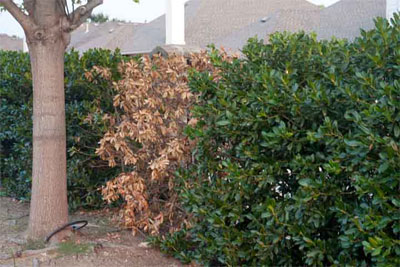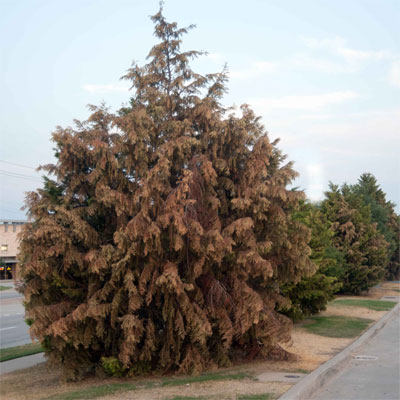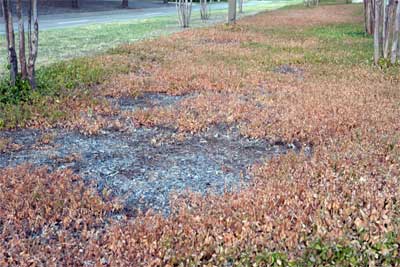Aftermath of the Drought

One Nellie R. Stevens holly in row has been lost, probably due to competition from tree’s roots.
I’ve begun each of my radio programs these past several weeks with the request, "If your question begins, ‘Neil, my plants’ leaves are all brown. Are they still alive?’ there is probably a 99 percent chance that you’ve let them get too dry at least one time in the past two or three months." I’ve gone on to say, "There really isn’t much reason for you to call, because that’s probably all I’ll be able to tell you anyway. Plus, it would make for three hours of repetitive radio."
But, let’s address some of those issues here and now:
Native Trees
Large native trees in wooded areas of the eastern half of Texas have been browning for the past several weeks. That’s been their natural way of coping with the hot, dry conditions. I’ve been gardening in Texas, with six years’ exception, since 1958, and I’ve seen several really bad summers. Admittedly, this is the worst, but most large, old trees went through those droughts of the 50s, 1980, late 90s and 2005-2006 and are still alive today. Most will make it through this one if we get some rains this fall. We can’t water the native woodlands anyway, so we might as well worry about something else.
Shade Trees
Mature shade trees, to a lesser extent, have been doing the same thing that woodland trees are doing in my notes above. They’re just acknowledging that 2011 isn’t going to amount to much. They’re shedding tons of leaves, and they’re dropping them early. Better species should be fine if we get fall and winter rains. In the meantime, water as you are able.
Where you need to worry more is with the less durable, fast-growing shade trees that struggle with all manner of insects and diseases. These trees have been weakened by the drought, and they’re going to be far more vulnerable to pest invasion. My bet is that we’ll find that we’ve lost a greater percentage of silver maples, mimosas, cottonwoods, fruitless mulberries, willows, Arizona ashes and other short-lived species when trees leaf out next spring.

20-year-old Leyland cypress trees have died due to simple neglect. Just a few dollars’ worth of water would have saved them.
Evergreen Shrubs and Trees
While deciduous plants are dropping leaves early, many of our evergreens are drying and dying in place. They don’t have the mechanism for dropping leaves to get through the drought. I’ve seen hundreds of southern magnolias, Leyland cypresses, hollies, Indian hawthorns and even native eastern redcedar junipers turning brown. Sadly, those plants usually don’t come back. Once browned, they’re usually gone.
Deciduous Shrubs
Crape myrtles, althaeas, forsythias and other deciduous shrubs have lost many leaves. In fact, unirrigated plants may be completely bare already. That’s probably not a good sign for any of them, and you certainly need to get water to them as soon as you can. Crape myrtles will be the most forgiving. They seem to bounce back better than most species, but they won’t bloom as well next year if you don’t water them soon.

Very large median bed of purple wintercreeper euonymus has been allowed to dry beyond permanent wilting point. Bare area marks a prior year’s drought where the groundcover did not come back.
Groundcovers
Asian jasmine beds have died by the thousands. That’s really sad, too, because they take several years to establish, not to mention the expense of preparing the soil and buying and planting new plants. Once their leaves turn olive drab, then become tan and folded, the plants are pretty well gone. That’s sad, too, because it doesn’t take much water to keep Asian jasmine alive.
English ivy is the other big victim of the heat. If it sticks out into the sun at all, its leaves may be sunburned in large, light brown blotches. English ivy is a shade groundcover, but if trees lose their leaves early as we’ve already described, the ivy can be shoved into hot sun. Keep it moist and it should survive. You’ll certainly have some tidy-up work to do when the weather begins to turn cool.
Roses
This summer has brutalized our roses. If you have browned buds and misshapen plants, do a bit of modest clean-up pruning to reshape the plants now. Try not, however, to remove more than 10 or 15 percent of their top growth this late in the season. You’re just trying to help them look more presentable for the next several months. If they were vigorous going into the summer, they should be fine heading toward winter and spring 2012. (For more information on rose care, see Rosarian Mike Shoup’s “Rose Cuttings” this issue.)
Lawns
I’ve always contended that we Texans water our lawns too much, but I’m singing a new tune this year. People have just walked away from their lawns, and that’s really too bad. Lawns are of significant value when it comes time to sell a house, plus your lawn is the carpet of your outdoor living spaces. Without a lawn, you don’t really have a landscape.
If you have bermuda turf, resume watering as soon as you’re able. If you have St. Augustine, you’ll need to water and assess the magnitude of your losses. Hopefully, you’ll have enough to repopulate the area. Otherwise, you may want to sow ryegrass for temporary cover this winter, and start planning now for replantings next spring. Zoysias are somewhat intermediate, but because of the cost of zoysia sod and the amount of time it takes to establish, hopefully you haven’t lost any of your zoysia lawn. If you’re in Northwest Texas, you probably have voids in your fescue lawn, and your normal September overseeding should take care of the issues.

